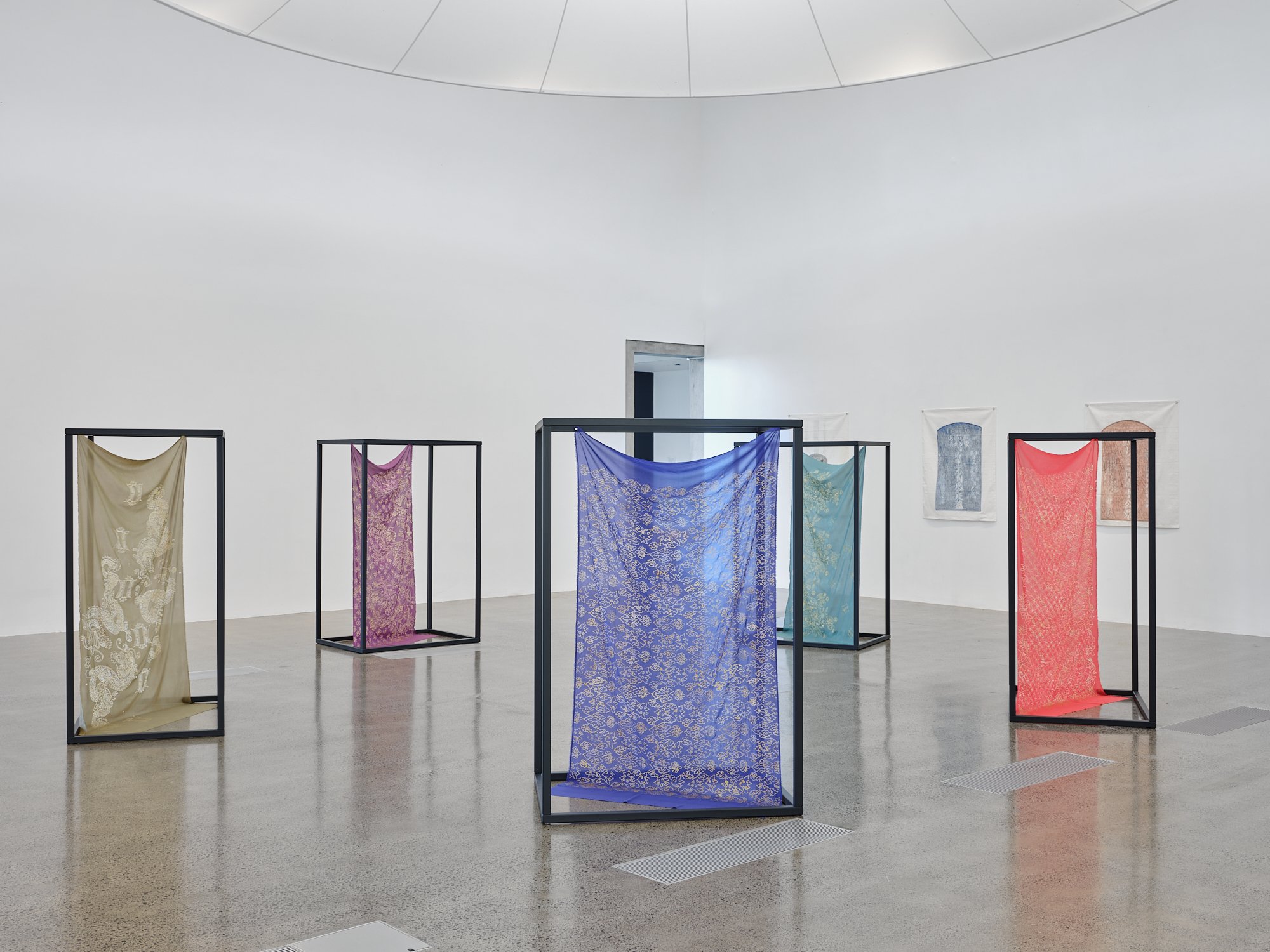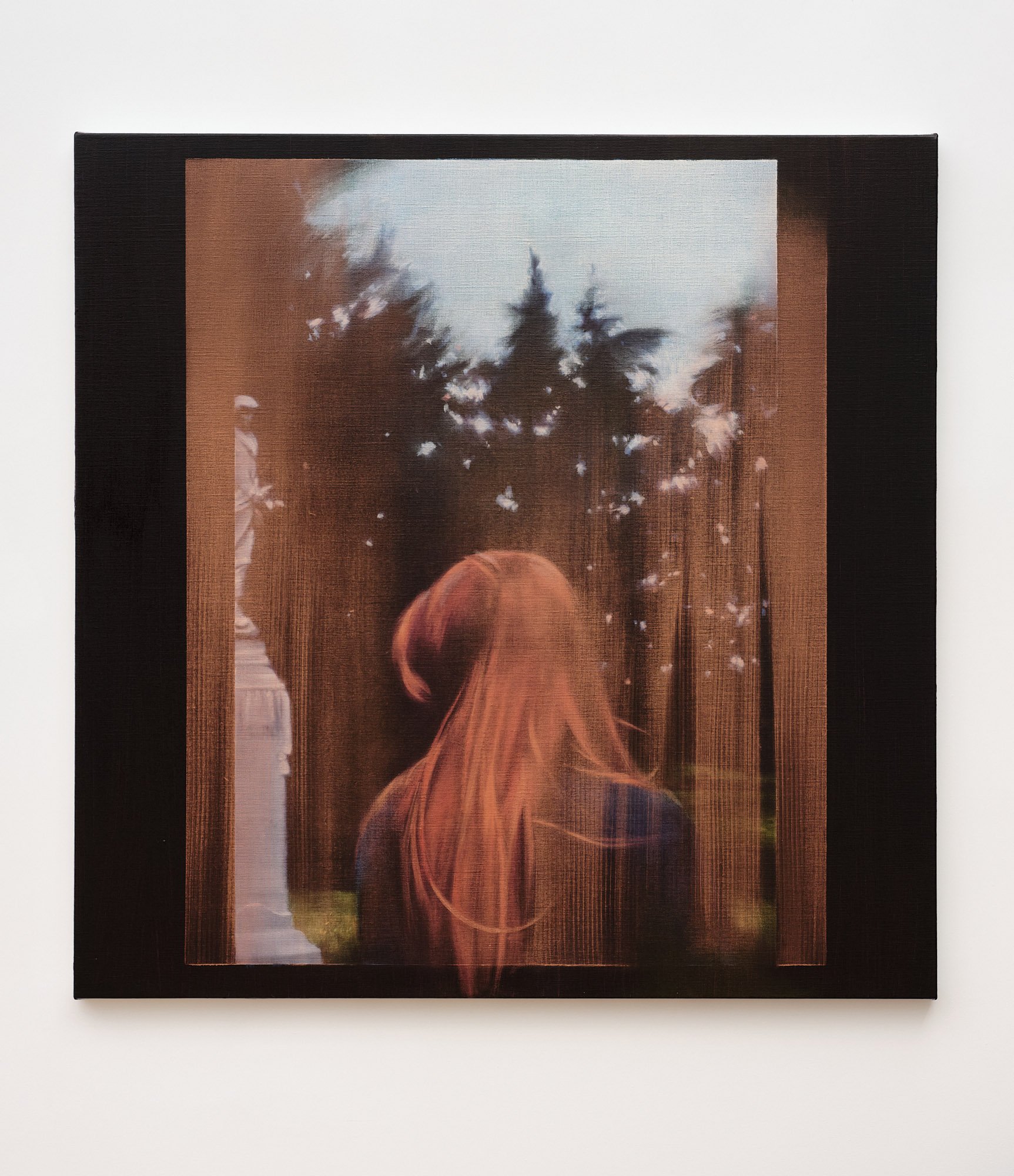Contours of migration
Dr Kirsty Baker on Rozana Lee’s Sekali pendatang, tetap pendatang at Te Uru Waitākere Contemporary Gallery, 18 March – 30 July 2023.
Rozana Lee, Sekali pendatang, tetap pendatang. Installation view, Te Uru Waitakere Contemporary Gallery, June 2023
The contours of migration are etched across the earth’s surface, tracing the invisible wake of human movement upon oceans and across the land. In the exhibition Sekali pendatang, tetap pendatang (Once an immigrant, always an immigrant), Rozana Lee responds to the entangled mesh of these contours as they intersect with personal and national understandings of belonging and history.
Lee, of Chinese-Indonesian heritage, was born and raised in the Indonesian city of Banda Aceh. Her childhood was marked by the shifting tides of anti-Chinese legislation and the racial violence and political tension these precipitated. Born five years after the 1965–66 anti-communist purge, which resulted in mass killings of ethnic Chinese across Indonesia, Lee grew up in a climate shaped by the enduring legacy of this violence. In 1998, amidst a renewed wave of anti-Chinese rioting, she fled the country, spending twelve years in Singapore before settling in Aotearoa.
The migratory pathways—woven through with dispossession, loss and hope—which have shaped the lives of Lee and her family are the foundational ground from which this exhibition has grown. The roots of her poetic visual language have emerged from an embrace of movement and mobility, as she forges a way of belonging that negotiates collective memory and generational trauma. In the film Sekali pendatang, tetap pendatang, from which the exhibition takes its name, Lee enacts a return journey to her family’s textile shophouse in Banda Aceh. Through the handheld lens of her camera, we watch from a plane window as the expansive blue of sky and ocean give way to the scattered fringes of the Indonesian archipelago. As this physical journey unfolds, so too does a temporal one. The text which overlays the filmed footage outlines a history of the land below that encompasses colonisation, legislation, state violence and racial discrimination.
Rozana Lee, Shape of Love 5, 2022, oil pastel rubbings on calico. Installation view, Te Uru Waitākere Contemporary Gallery. Photo: Sam Hartnett
Within the context of this contentious national history, Lee visits sites which resonate with personal stories of loss and memory. We watch as she travels to her family shophouse, and the tombs of her parents. Her mother’s grave is unmarked, her body thought to be one of the 46,718 nameless victims of the 2004 boxing day tsunami buried at the Siron Tsunami Memorial Park. In contrast to the anonymity of this site of mass burial, her father’s tomb—like those of her grandmother, grandfather, great grandmother and great-great grandmother—is marked by language. These marked sites are represented in the exhibition by Shapes of love, a series of five oil pastel rubbings on calico. These traced images act as both visual representation and indexical trace of the place where they were made. In Sekali pendatang, tetap pendatang we watch as Lee and her brother quietly visit these tombs, accompanied by the sound of a breeze pushing against the overgrown vegetation and the quiet chirp of birdsong. We see her methodically create the rubbings that will become Shapes of love, carefully stretching the calico flat and drawing oil pastels across their surface. By using this method of direct physical transference, rather than simply photographing the tombs, Lee privileges a form of recording—and of remembering—that extends beyond the visual. The haptic trace of her hand stretches from tomb to calico, from cemetery to art gallery, imbuing the work with a material sense of historical and personal remembering.
Stretched between steel posts, the fabric projection screen for Sekali pendatang, tetap pendatang is reminiscent of the calico that Lee draped across these ancestral tombs. It, too, carries the weight of another place into the gallery. Salvaged from the damaged remains of her family’s shop, this tsunami-soiled fabric carries the weight of loss. Though water damage remains visible within its fibres, much of the personal damage caused by the tsunami remains unseen. However, through the act of reclamation and repurposing, Lee inscribes this fabric with the power of collective memory and love. She understands the power of materiality, the ways that physical objects—in this instance fabric marked by pigment or water—can act as holders of memory, of experience, of history.
In the works which make up Cages of memories Lee once again turns to fabric as a site to forge a visual language of meaning. Utilising an adaptation of the batik processes which are widespread across Indonesia, Lee uses hot wax as drawing medium. Rather than removing this wax from the fabric once it is dyed, she subverts this process by allowing it to remain. The contours of this solidified wax become three-dimensional, their raised surfaces forming ridges of pattern across the fine weave of the silk. Subject to movement as the fabric shifts and folds, these contours are fragile and brittle, etched with fine cracks and breakage. The precarity of wax as a drawing medium is emphasised by the method of display Lee has employed for the works. Having worked extensively with wax-drawn textiles, she has experimented with various modes of display: whether cascading vertically from a gallery ceiling, or mounted within freestanding wooden frames. Here she has designed and commissioned the fabrication of large scale powder-coated steel frames, or cages. Operating in three dimensions, these cages are human in scale. They surround the diaphanous spills of fabric, which hang suspended within them, while allowing the viewer to circle the fabric works to view them from all angles. This sculptural mode of presentation draws out a bodily mode of viewing. Our bodies circle the cages as we visually trace the dense intricacy of the patterns stretched across the surface of the silk.
Now living in Aotearoa, as a fourth-generation descendant of Chinese immigrants to Indonesia, Lee’s visual vocabulary draws on a wide range of symbolic imagery from across these cultures. In Lotus and Kawung, for instance, she creates a rhythmic all-over pattern which twines the lotus flower together with the Kawung—or four petal flower. The Kawung pattern is one of the oldest and most widespread in Indonesian batik, and was adapted from Buddhist lotus flower imagery. By bringing these forms into direct communication, Lee highlights both the commonality and adaptation of visual imagery across cultural traditions. Where Lotus and Kawung is dominated by an all-over pattern, in Naga and Pintu Aceh vast swathes of the dyed silk’s golden ochre are left untouched. Against this background, a pulsing swirl of movement dances down the fabric. Four intricately drawn Chinese dragons, symbolic of heavenly power, border the vertical sweep of the silk. Six irregularly spaced doorways punctuate its central line. These Pintu Aceh—or doors of Aceh—represent Lee’s hometown, emphasising the port city’s significance as the ‘gateway to Mecca’.
A gateway or door, much like a port, serves as a transitional space, a threshold between places and between modes of belonging. The patterns of migration that have shaped Lee’s artistic practice are embedded in a mode of making that embraces this site of motion and transition, adapting techniques and imagery to forge a way of existing that honours both past and future. Throughout the exhibition we see Lee in constant motion – walking the streets of Aceh, driving from one place to another, looking at the landscape that slides past the window of a train as she arrives in Huizhou, journeying across the ocean in a plane. In the film Lines of separation, Lee travels to visit her ancestral homeland in China. As her contemplative journey unfolds, she quotes a poem written by her friend M Farzaneh. ‘The arrow that is life shoots into the river,’ she says, ‘and flows to dwell in deeper frontiers.’ This exhibition suggests that this sense of motion, the forward momentum of life’s arrow, holds the potential to become a site of belonging itself.
Rozana Lee, Cages of memories: Lilies, Stars, and quartrefoils, 2022, hot wax hand-drawing on silk, hand-dyed, powder coated steel frame. Installation view, Te Uru Waitākere Contemporary Gallery. Photo: Sam Hartnett
Rozana Lee, Cages of memories: Lotus and Kawung, 2022, hot wax hand-drawing on silk, hand-dyed, powder coated steel frame. Shape of Love 5, 2022, oil pastel rubbing on calico. Installation view, Te Uru Waitākere Contemporary Gallery. Photo: Sam Hartnett
Rozana Lee, Sekali pendatang, tetap pendatang, 2022, (HD) single-channel video, 15:14 mins, colour, sound, and text, rear-projected onto 2004 tsunami-soiled fabric screen on powder-coated steel posts. Installation view, Te Uru Waitākere Contemporary Gallery. Photo: Sam Hartnett
Rozana Lee, Sekali pendatang, tetap pendatang. Installation view, Te Uru Waitakere Contemporary Gallery, June 2023
Rozana Lee, Sekali pendatang, tetap pendatang. Installation view, Te Uru Waitakere Contemporary Gallery, June 2023
Rozana Lee, Sekali pendatang, tetap pendatang. Installation view, Te Uru Waitakere Contemporary Gallery, June 2023
Rozana Lee, Sekali pendatang, tetap pendatang. Installation view, Te Uru Waitakere Contemporary Gallery, June 2023














We visited the opening of Kith and Kin on Friday 2 August at Season, featuring brunelle dias, Tony Guo, Levi Kereama, Claudia Kogachi, and Jacqueline Fahey.